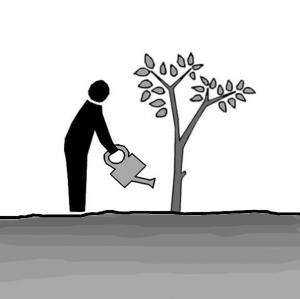Resumen ejecutivo
Stored urine that has been separately collected and hygienised, is a concentrated source of nutrients that can be applied as a liquid fertilizer in agriculture and replace all or some commercial chemical fertilizers. This factsheet focuses on small-scale urine use, which refers to the application of urine on small fields, beds, vertical or container gardens, school gardens, plant pots on terraces, rooftops etc. that can be done on a household or smaller community level without sophisticated transport and application infrastructure. See the factsheet on large scale urine use here.
| Entradas | Salidas |
|---|---|
Urine, Yellowwater, Fertiliser |
Food Products |
Introduction
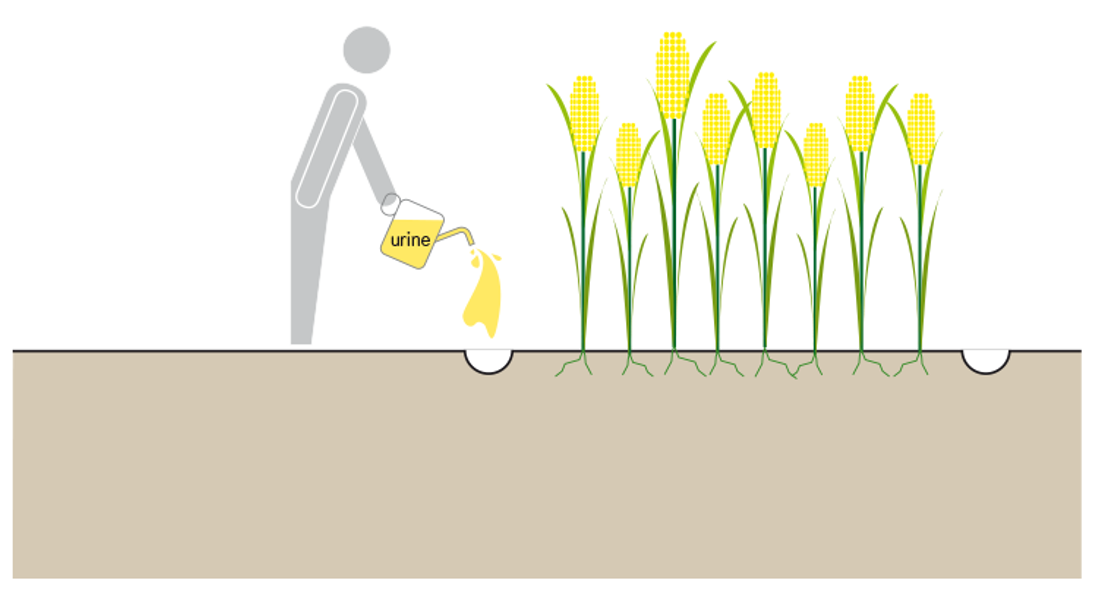
Urine is a liquid product of the human body that is secreted by the kidneys. The amount of urine produced per person and day depends on the amount of liquid a person drinks, but usually lies within a range of 0.8 to 1.5 L per day for an adult person and about half as much for children, respectively (WHO 2006). On average, an adult person produces around 500 L (550 kg) of urine per year, thus approximately 4 kg of N, 0.5 kg of P and 1 kg of K per person per year (JOENSSON 2004). Urine can therefore be considered as a nitrogen rich liquid fertiliser. Due to its comparably high N and low organic matter content it is often recommended to complement urine application with other nutrient and organic matter sources.
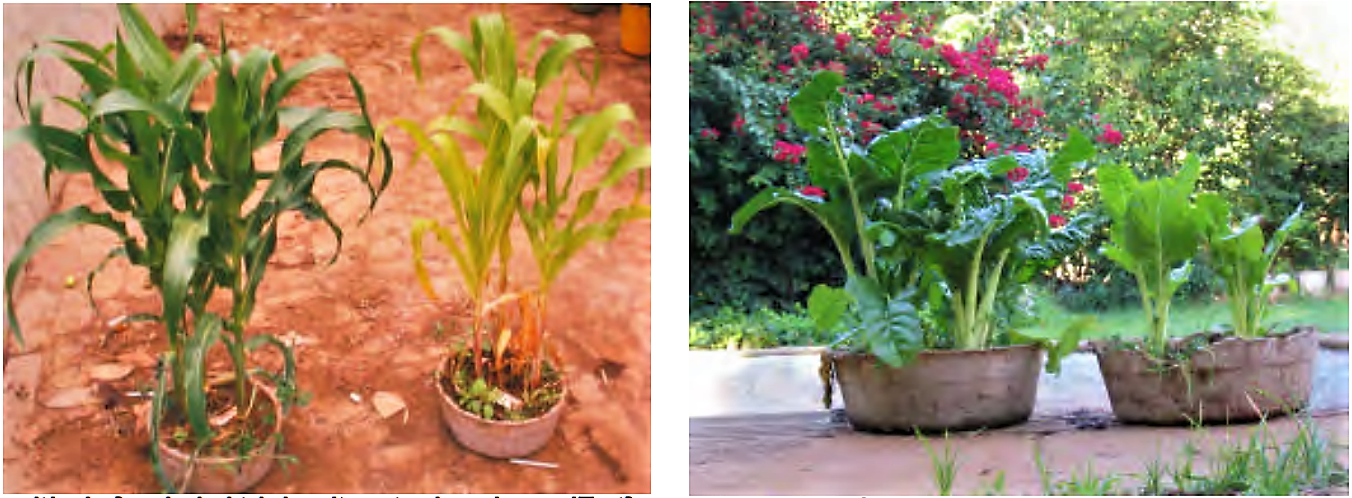
In respect of the 0.5 kg of phosphorus, and taking into account fertilizer prices from the Nepalese market in 2008 (35 NRs/kg NPK fertiliser (ratio 20:20:10) (GANTENBEIN 2009)), this is thus equivalent to 1.2$ per capita per year and 9$ if we consider a family equivalent to 7 adult members. This may not seem a lot, but of course, more money can be saved or income generated from the plants produced.
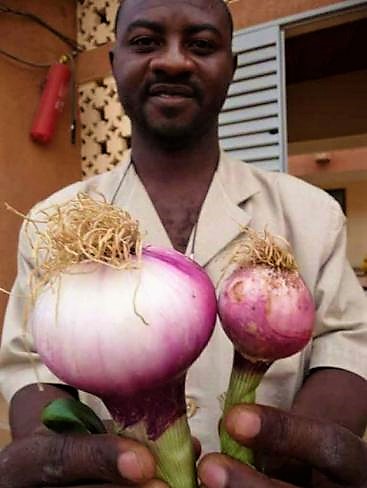
The guidelines for urine use are based on storage time and temperature (see WHO guidelines on excreta use in agriculture for specific requirements). However, it is generally accepted that if urine is stored for at least 1 month, it will be safe for agricultural application at the household level. If urine is used for crops that are eaten by people other than the urine producer, it should be stored beforehand for 6 months. You can find more information in the factsheet regarding storage of urine. During storage, high pH (above 9), temperature and ammonia are the main factors for inactivating pathogens (SCHOENNING 2004). The rise of pH to above 9 occurs naturally, when urea is degraded to ammonium. At this pH, the initial concentrations of phosphate, magnesium, calcium and ammonia are no longer soluble, but precipitate forming a bottom layer containing phosphor precipitates (struvite), which can be handled as fertiliser together with the rest of the urine. Special attention should however be paid on the ventilation of the urine collection and storage chamber. Because of the high pH, coupled with the high ammonium concentration of urine, there is a risk of losing N in the form of ammonia to the air. As long as the collection and storage chambers are sealed and the contact of the urine with air is reduced to a minimum, neither losses of nutrients nor changes in their availability can occur (JOENSSON 2004).
Another beneficial use of urine is as an additive to enrich compost. Technologies for the production of urine-based fertilizers are currently also under research (e.g., struvite, Emerging Sanitation Technologies).
From normal, healthy people, urine is virtually free of pathogens. Urine also contains the majority of nutrients that are excreted by the body. Its composition varies depending on diet, gender, climate, water intake, etc., but roughly 88% of nitrogen, 61% of phosphorus and 74% of potassium excreted from the body is in urine.
Design Considerations
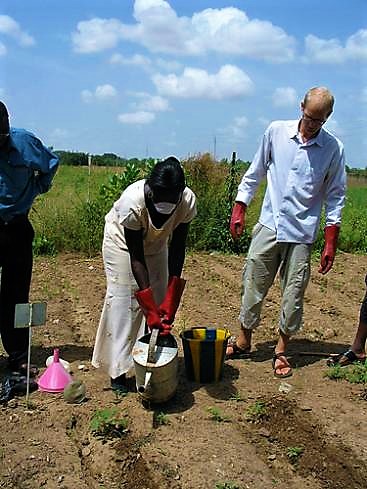
Stored urine should not be applied directly to plants because of its high pH and concentrated form. Instead, it can be:
1) mixed undiluted into soil before planting;
2) poured into furrows, but at a sufficient distance away from the roots of the plants and immediately covered (although this should take place no more than once or twice during the growing season); and
3) diluted several times, whereby it can be frequently used around plants (up to two times weekly).
The optimal application rate depends on the nitrogen demand and tolerance of the crop on which it will be used, the nitrogen concentration of the liquid, as well as the rate of ammonia loss during application. Because of its high nitrogen content, urine should be applied at a rate corresponding to the desired plant nitrogen requirements. A starting point for dimensioning urine application is local recommendations for use of mineral nitrogen fertilisers. As a general rule of thumb, one can assume that 1 m2 of cropland can receive 1.5 L of urine per growing season (this quantity corresponds to the daily urine production of one person and to 40-110 kg N/ha). The urine of one person during one year is, thus, sufficient to fertilize 300 to 400 m2 of cropland.
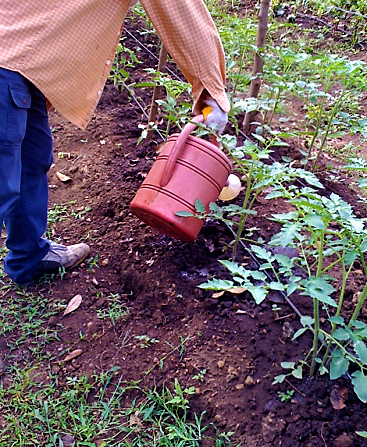
A 3:1 mix of water and urine is an effective dilution for vegetables, although the correct amount depends on the soil and the type of vegetables. If diluted urine is used in an irrigation system, it is referred to as “fertigation”. For best fertilizing effect and to avoid ammonia losses to the air, urine should be incorporated into the soil as soon as possible after application, preferably instantly. Equipment that can be used for the application comprises watering cans, dippers, but also empty water bottles cut into half etc. A shallow incorporation is enough, and different methods are possible. One is to apply urine in small furrows that are covered after application. Washing the nutrients into the soil with subsequent application of water is another option. When spreading urine, it should not be applied on leaves or other parts of the plants, as this can cause foliar burning. During the rainy season, urine can also be applied directly into small holes near plants; then it is diluted naturally.
A good availability of nutrients is particularly important in early stages of cultivation. Once the crop enters its reproductive stage it hardly takes up any more nutrients. Fertilizations should stop after between 2/3 and 3/4 of the time between sowing and harvest.
Health Aspects/Acceptance
Urine poses a minimal risk of infection, especially when faecal cross contamination during source separation is avoided and it has been stored for an extended period of time. Yet, urine should be carefully handled and should not be applied to crops less than one month before they are harvested. This waiting period is especially important for crops that are consumed raw (refer to WHO guidelines for specific guidance).
Social acceptance may be difficult. Stored urine has a strong smell and some may find it offensive to work with it or to have it nearby. If urine is diluted and/or immediately tilled into the earth, however, its smell can be reduced. The use of urine may be less accepted in urban or peri-urban areas when household gardens are close to peoples’ homes than in rural areas where houses and crop land are kept separate.
Operation & Maintenance
Over time, some minerals in urine will precipitate (especially, calcium and magnesium phosphates). Equipment that is used to collect, transport or apply urine (i.e., watering cans with small holes) may become clogged over time. Most deposits can easily be removed with hot water and a bit of acid (vinegar), or in more extreme cases, manually chipped off.
Urine is especially beneficial for crops lacking in nitrogen or requiring a lot of nitrogen to grow . Examples of some crops that grow well with urine include: maize, rice, millet, sorghum, wheat, chard, turnip, carrots, kale, cabbage, lettuce, bananas, paw-paw, and oranges. Urine application is ideal for rural and peri-urban areas where agricultural lands are close to the point of urine collection. Households can use their own urine on their own plot of land. Alternatively, if facilities and infrastructure exist, urine can be collected at a semi-centralized location for distribution and transport to agricultural land. Regardless, the most important aspect is that there is a need for nutrients from fertilizer for agriculture which can be supplied by the stored urine. When there is no such need, the urine can become a source of pollution and a nuisance.
Struvite Recovery from Urine at Community Scale in Nepal Final Project Report Phase I.
Guidelines on the Use of Urine and Faeces in Crop Production
These guidelines provide a thorough background on the use of urine (and faeces) for agricultural purposes. Aspects discussed are requirements for plant growth, nutrients in excreta, hygiene aspects, and recommendations for cultivation. It provides detailed guidance on the use of urine for purposes.
JOENSSON, H. RICHERT, A. VINNERAAS, B. SALOMON, E. (2004): Guidelines on the Use of Urine and Faeces in Crop Production. (= EcoSanRes Publications Series , 2004 ). Stockholm: EcoSanRes URL [Visita: 17.04.2012]The Usefulness of Urine
The chapter "the usefulness of urine" is about different methods of collecting urine, storage, uses of urine in agriculture and gives various examples of using urine to enhance vegetable production in containers and on fields
MORGAN, P. (2004): The Usefulness of Urine. Part III, chapter 14. Entradas: Morgan, P. ; (2014): An Ecological Approach to Sanitation in Africa. A Compilation of Experiences. Harare: pp. 174-189. URL [Visita: 26.05.2019]Toilets That Make Compost
This book describes in an easy-to-understand and picture-based way how to construct three different low cost sanitation solutions, namely arborloos, fossa alterna and urine diversion toilets.
MORGAN, P. EcoSanRes (2007): Toilets That Make Compost . Stockholm: Stockholm Environment Institute URL [Visita: 09.05.2019]Technology Review of Urine Diversion Components
The publication explains the purposes of urine diversion, its benefits and challenges, urine precipitation, urine treatment and reuse in agriculture. Further, it provides an overview on design and operational aspects for equipment needed, such as waterless urinals and urine diversion toilets including supplier information and indicative costs. Overall, it pulls together scattered knowledge around the topic of urine diversion in a concise manner.
MUENCH, E. von WINKER, M. (2011): Technology Review of Urine Diversion Components. Overview of Urine Diversion Components such as Waterless Urinals, Urine Diversion Toilets, Urine Storage and Reuse Systems. Eschborn: Deutsche Gesellschaft für Internationale Zusammenarbeit (GIZ) GmbH URL [Visita: 11.05.2019]Practical Guidance on the Use of Urine in Crop Production
This practical guideline on the use of urine in agricultural productions gives some background information on basic plant requirements and how they can be met with urine as a liquid fertiliser.
RICHERT, A. GENSCH, R. JOENSSON, H. STENSTROEM, T.A. DAGERSKOG, L. (2010): Practical Guidance on the Use of Urine in Crop Production. (= EcoSanRes Publication Series, Report No. 2010-1 ). Stockholm: Stockholm Environment Institute (SEI) URL [Visita: 26.05.2019]Guidelines on the Safe Use of Urine and Faeces in Ecological Sanitation Systems
These guidelines provide a thorough background on the safe use of urine and faeces for agricultural purposes. Aspects like the health risk associated we the use of human excreta in agriculture and how to limit them are discussed.
SCHOENNING, C. STENSTROEM, T.A. (2004): Guidelines on the Safe Use of Urine and Faeces in Ecological Sanitation Systems. (= EcoSanRes Publication Series ). Stockholm: Stockholm Environment Institute (SEI)Compendium of Sanitation Systems and Technologies. 2nd Revised Edition
This compendium gives a systematic overview on different sanitation systems and technologies and describes a wide range of available low-cost sanitation technologies.
TILLEY, E., ULRICH L., LÜTHI, C., REYMOND P. and ZURBRÜGG C. (2014): Compendium of Sanitation Systems and Technologies. 2nd Revised Edition. Duebendorf, Switzerland: Swiss Federal Institute of Aquatic Science and Technology (Eawag) URL [Visita: 03.05.2023] PDFGuidelines for the safe use of wastewater excreta and greywater. Volume III. Wastewater and Excreta Use in Aquaculture
Volume III of the Guidelines for the Safe Use of Wastewater, Excreta and Greywater deals with wastewater and excreta use in aquaculture and describes the present state of knowledge regarding the impact of wastewater-fed aquaculture on the health of producers, product consumers and local communities. It assesses the associated health risks and provides an integrated preventive management framework.
WHO (2006): Guidelines for the safe use of wastewater excreta and greywater. Volume III. Wastewater and Excreta Use in Aquaculture. Geneva: World Health Organisation URL [Visita: 08.05.2019]Guidelines for the safe use of wastewater excreta and greywater. Volume IV. Excreta and Greywater Use in Agriculture
Volume IV of the Guidelines for the Safe Use of Wastewater, Excreta and Greywater recognizes the reuse potential of wastewater and excreta (including urine) in agriculture and describes the present state of knowledge as regards potential health risks associated with the reuse as well as measures to manage these health risks following a multi-barrier approach.
WHO (2006): Guidelines for the safe use of wastewater excreta and greywater. Volume IV. Excreta and Greywater Use in Agriculture. Geneva: World Health Organisation (WHO) URL [Visita: 09.05.2019] PDFGuidelines on the Use of Urine and Faeces in Crop Production. Factsheet
A 2-page factsheet summarizing the EcoSanRes ‘Guidelines on the Use of Urine and Faeces in Crop Production’ publication with short information on urine as a fertilizer, application rates etc.
ECOSANRES (2008): Guidelines on the Use of Urine and Faeces in Crop Production. Factsheet. (pdf presentation). (= EcoSanRes Factsheet , 6 ). Stockholm: Stockholm Environment Institute URL [Visita: 31.05.2019]Large Scale Handling of Urine and Faeces
Compendium of Sanitation Systems and Technologies (Arabic)
This is the Arabic version of the Compendium of Sanitation Systems and Technologies. The Compendium gives a systematic overview on different sanitation systems and technologies and describes a wide range of available low-cost sanitation technologies.
TILLEY, E. ULRICH, L. LUETHI, C. REYMOND, P. SCHERTENLEIB, R. ZURBRUEGG, C. (2014): Compendium of Sanitation Systems and Technologies (Arabic). 2nd Revised Edition. Duebendorf, Switzerland: Swiss Federal Institute of Aquatic Science and Technology (Eawag) PDFFertilisation with Urine in Agriculture – in a Nutshell
This leaflet provides a summary on why and how to fertilize with urine including brief application recommendations, hygiene considerations and trouble shooting support.
VALLEY VIEW UNIVERSITY (2008): Fertilisation with Urine in Agriculture – in a Nutshell. University of Hohenheim Germany: Berger Biotechnik and Valley View University Ghana.Practical Guidance on the Use of Urine in Crop Production
This practical guideline on the use of urine in agricultural productions gives some background information on basic plant requirements and how they can be met with urine as a liquid fertiliser.
RICHERT, A. GENSCH, R. JOENSSON, H. STENSTROEM, T.A. DAGERSKOG, L. (2010): Practical Guidance on the Use of Urine in Crop Production. (= EcoSanRes Publication Series, Report No. 2010-1 ). Stockholm: Stockholm Environment Institute (SEI) URL [Visita: 26.05.2019]Urine as Liquid Fertilizer in Agricultural Production in the Philippines
This field guide has been developed to accommodate the ever-increasing demand for more detailed and scientifically backed information on how to use urine in agricultural production. It is intended primarily for practitioners and experts in the water, sanitation, planning, and agriculture sectors, as well as local and national government officials from the various sectors, NGO and individuals interested and working in the field of agriculture and sustainable sanitation in the Philippines and the wider Southeast Asian region.
GENSCH, R. MISO, A. ITSCHON, G. (2011): Urine as Liquid Fertilizer in Agricultural Production in the Philippines. Cagayan de Oro: Sustainable Sanitation Center Xavier University (XU), the Philippine Sustainable Sanitation Knowledge Node, the Philippine Ecosan Network, and the Sustainable Sanitation Alliance (SuSanA) URL [Visita: 07.05.2019]Urine and Faeces as Fertilizers in the CREPA Network
Presentation on experiences with the use of urine (and faeces) in agriculture including research results, conducted taste tests and calculations on the fertiliser value.
DAGERSKOG, L. SuSanA (2009): Urine and Faeces as Fertilizers in the CREPA Network. pdf presentation. (= SuSanA presentation WG , 5 ). Ouagadougou: Sustainable Sanitation Alliance URL [Visita: 27.05.2019]Philippine Allotment Garden Manual
This manual provides information on the allotment garden project in Cagayan de Oro including an introduction to Ecosan and the use of treated urine in the gardens.
HOLMER, R. SANTOS, C. SOL, G. LEE, S. ELORDE, E. AQUINO, A. GUANZON, Y. ACHAS, D. CASERIA, J. FACTURA, H. MISO, A. OCLARIT, R. MONTES, A. Periurban Vegetable Project (PUVeP) (2008): Philippine Allotment Garden Manual. (pdf presentation). Cagayan de Oro City: Xavier University College of AgricultureGuidelines on the Use of Urine and Faeces in Crop Production
These guidelines provide a thorough background on the use of urine (and faeces) for agricultural purposes. Aspects discussed are requirements for plant growth, nutrients in excreta, hygiene aspects, and recommendations for cultivation. It provides detailed guidance on the use of urine for purposes.
JOENSSON, H. RICHERT, A. VINNERAAS, B. SALOMON, E. (2004): Guidelines on the Use of Urine and Faeces in Crop Production. (= EcoSanRes Publications Series , 2004 ). Stockholm: EcoSanRes URL [Visita: 17.04.2012]Experiments at Recycling Urine in School Gardens
Garden Trials Using Urine as a Plant Food
Guidelines on the Use of Urine and Faeces in Crop Production. Factsheet
A 2-page factsheet summarizing the EcoSanRes ‘Guidelines on the Use of Urine and Faeces in Crop Production’ publication with short information on urine as a fertilizer, application rates etc.
ECOSANRES (2008): Guidelines on the Use of Urine and Faeces in Crop Production. Factsheet. (pdf presentation). (= EcoSanRes Factsheet , 6 ). Stockholm: Stockholm Environment Institute URL [Visita: 31.05.2019]Guidelines for the safe use of wastewater excreta and greywater. Volume III. Wastewater and Excreta Use in Aquaculture
Volume III of the Guidelines for the Safe Use of Wastewater, Excreta and Greywater deals with wastewater and excreta use in aquaculture and describes the present state of knowledge regarding the impact of wastewater-fed aquaculture on the health of producers, product consumers and local communities. It assesses the associated health risks and provides an integrated preventive management framework.
WHO (2006): Guidelines for the safe use of wastewater excreta and greywater. Volume III. Wastewater and Excreta Use in Aquaculture. Geneva: World Health Organisation URL [Visita: 08.05.2019]Guidelines for the safe use of wastewater excreta and greywater. Volume IV. Excreta and Greywater Use in Agriculture
Volume IV of the Guidelines for the Safe Use of Wastewater, Excreta and Greywater recognizes the reuse potential of wastewater and excreta (including urine) in agriculture and describes the present state of knowledge as regards potential health risks associated with the reuse as well as measures to manage these health risks following a multi-barrier approach.
WHO (2006): Guidelines for the safe use of wastewater excreta and greywater. Volume IV. Excreta and Greywater Use in Agriculture. Geneva: World Health Organisation (WHO) URL [Visita: 09.05.2019] PDFRisk of Clogging of Drip-Line Emitters during Urine Fertilization through Drip Irrigation Equipment
UDD Toilets with Reuse in Allotment Gardens.
Case study on an urban agriculture project with urine reuse in Northern Mindanao, Philippines.
HOLMER, R. SuSanA (2009): UDD Toilets with Reuse in Allotment Gardens.. (pdf presentation). (= SuSanA case study ). Cagayan de Oro Philippines: Sustainable Sanitation Alliance URL [Visita: 11.08.2010]Community-Led Water and Ecosan Programme
Case study on a community led sanitation project that introduced UDDT, Biogas & Double Urn Toilets and use of urine in Shaanxi Province, China.
KUMAR, P. SuSanA (2008): Community-Led Water and Ecosan Programme. (= SuSanA case study ). Shaanxi Province, China: Sustainable Sanitation Alliance (SuSanA)UDD Toilets at a Rural Secondary School Kalunga, Uganda
Case study on a school UDDT project and the reuse of the collected urine in Kalunga, Uganda
MUELLEGGER, E. SuSanA (2009): UDD Toilets at a Rural Secondary School Kalunga, Uganda. (= SuSanA case study ). Sustainable Sanitation Alliance URL [Visita: 12.12.2012]Rural Community and School UDD Toilets in Misamis Oriental
Case study on a community and school UDDT project with urine reuse in Misamis Oriental, Philippines.
SAYRE, E. VON MUENCH, E. SuSanA (2009): Rural Community and School UDD Toilets in Misamis Oriental. (pdf presentation). (= SuSanA case study ). Libertad, Initao & Manticao, Philippines: Sustainable Sanitation ExchangeUrine and Faeces as Fertilizers in the CREPA Network
Presentation on experiences with the use of urine (and faeces) in agriculture including research results, conducted taste tests and calculations on the fertiliser value.
DAGERSKOG, L. SuSanA (2009): Urine and Faeces as Fertilizers in the CREPA Network. pdf presentation. (= SuSanA presentation WG , 5 ). Ouagadougou: Sustainable Sanitation Alliance URL [Visita: 27.05.2019]Using Urine to Increase Maize Production in Schools
This presentation exemplifies on how to increase maize production through the application of urine fertiliser.
MORGAN, P. SHANGWA, A. (2009): Using Urine to Increase Maize Production in Schools. The Chisungu Primary School Water and Sanitation project. Stockholm : Ecological Sanitation Research (EcoSanRes), Stockholm Environment Institute (SEI) URL [Visita: 31.05.2019]Growing Maize with the Help of Toilet Compost and Urine on Poor Sandy Soils
This document reports the field trials of application of urine and toilet compost on a maize field in Epworth in Simbabwe.
MORGAN, P. (2005): Growing Maize with the Help of Toilet Compost and Urine on Poor Sandy Soils. Stockholm : Ecological Sanitation Research (EcoSanRes), Stockholm Environment Institute (SEI) URL [Visita: 20.06.2013]Ecological Sanitation in Southern Africa
This document describes the ecological sanitation situation in South Africa, focussing on the range of technological options, promotional methods and recycling methods and the problem areas.
MORGAN, P. (2005): Ecological Sanitation in Southern Africa. Many Approaches to a Varied Need. Stockholm : Ecological Sanitation Research (EcoSanRes), Stockholm Environment Institute (SEI) URL [Visita: 21.06.2013]Ecological Sanitation in Malawi
This illustrative presentation on ecological sanitation in Malawi, focuses on the concept of ecological sanitation, types of eco-toilets and basic methods of recycling nutrient from human excreta.
MORGAN, P. (2010): Ecological Sanitation in Malawi. Stockholm : Ecological Sanitation Research (EcoSanRes), Stockholm Environment Institute (SEI) URL [Visita: 31.05.2019]The ROSA Project
The ROSA project stands for Resource-Oriented Sanitation concepts for peri-urban areas in Africa. This Sustainable Sanitation Practice (SSP) issue contains the following contributions: 1. Introduction to the ROSA Project, 2. From Pilot Units to Large-Scale Implementation - Ethiopia, 3. Implementation of UDDTs at Schools - Kenya, 4. Urban Agriculture for Sanitation Promotion, 5. Operation an Maintenance in Practice, 6. Experiences from Strategic Sanitation Planning, 7. Main Findings and Main Achievements.
MUELLEGGER, E. ; LANGEGRABER, G. ; LECHNER, M. (2010): The ROSA Project. (= Sustainable Sanitation Practice , 4 ). Vienna: Ecosan Club URL [Visita: 01.07.2013]Alternatives to Conventional Wastewater Systems
Drip Irrigation and Fertigation Prospective
The study aimed at assessing the feasibility of using urine as a fertilizer and drip irrigation technology to address food scarcity that has hit Uganda as a country of late. The study revealed high rates of return for a farmer who chooses to practice drip irrigation and fertigation. This however gives best results with effective disease control.
BAMUTAZE, A.B.N. BABIRYE, V. (2013): Drip Irrigation and Fertigation Prospective. A Case Study of Cabbage Growing at the ATC, Mukono District. Mukono: Appropriate Technology Centre (ATC) for Water and Sanitation URL [Visita: 21.10.2013]M4-7: Agricultural Aspects
Lecture on agricultural aspects of ecosan comprising chapters on plant requirements, composition and plant availability of nutrients in human excreta as well as general application recommendations and safety measures.
JENSSEN, P. HEEB, J. GANAKAN, K. CONRADIN, K. (2008): M4-7: Agricultural Aspects. Entradas: HEEB, J. ; JENSSEN, P. ; GNANAKAN ; CONRADIN, K. ; (2008): Ecosan Curriculum 2.3. Switzerland, India and Norway: [Accessed: 21.03.2011]. PDFExcreta Use in Agriculture, Lecture taken from the XU Ecosan Course
Ecosan – Assainir Pour Produire Plus!. Burkina Faso
How to Separate Urine
This flyer contains information about the importance of urine reuse. The nutrients in urine are easily taken up by plants. The fertilised plant will grow faster, develop more leaves and produce higher yields. Applying urine to crops instead of chemical fertilisers saves money and energy and produces a similar yield. One person produces about 500 liter urine per year.
WECF (2010): How to Separate Urine. Utrecht/Munich/Annemasse: Women in Europe for a Common Future URL [Visita: 06.01.2011]Big, Sweet Tomatoes - Food Security and Productive Sanitation
This link provides information on the Stockholm World Water Week Session ‘Big Sweet Tomatoes – Food Security and Productive Sanitation’ that focussed on a project funded by the International Fund for Agricultural Development (IFAD) in Niger with a strong focus on urine reuse.

